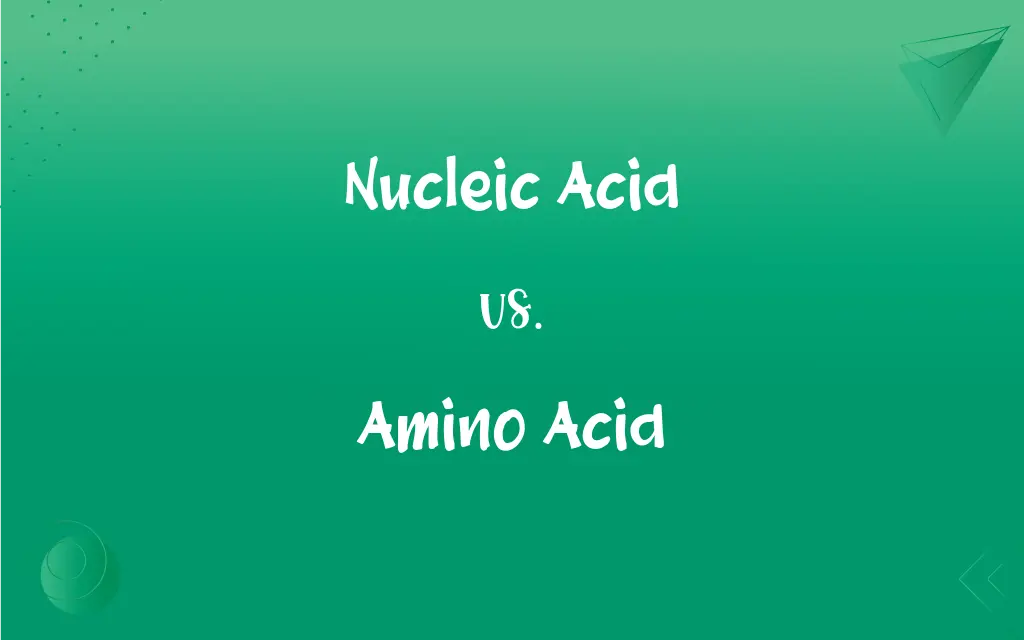Nucleic Acid vs. Amino Acid: What's the Difference?
Edited by Aimie Carlson || By Harlon Moss || Published on November 21, 2023
"Nucleic acids are macromolecules forming DNA and RNA; amino acids are organic compounds building proteins."

Key Differences
Nucleic acids, comprising DNA and RNA, are essential for genetic information storage and transmission in living organisms. Amino acids, on the other hand, are the building blocks of proteins, crucial for numerous biological functions.
The structure of nucleic acids includes a sugar, phosphate group, and nitrogenous base, forming long chains. While, amino acids consist of a central carbon atom, an amino group, a carboxyl group, and a variable side chain.
Nucleic acids encode genetic instructions used in the development and functioning of all living organisms. Whereas, amino acids are involved in the synthesis of proteins, which perform a variety of roles in the body, including catalyzing metabolic reactions and replicating DNA.
The two types of nucleic acids are DNA, which stores genetic information, and RNA, which plays a role in protein synthesis. In contrast, there are twenty standard amino acids that combine in various sequences to form proteins.
Nucleic acids are found in the nucleus of cells, while amino acids are synthesized in the cell's cytoplasm or obtained through diet. Understanding both is essential for comprehending life processes at a molecular level.
ADVERTISEMENT
Comparison Chart
Basic Function
Carries genetic information
Builds proteins
Composition
Sugar, phosphate, nitrogenous base
Central carbon, amino group, carboxyl group, side chain
Types
DNA and RNA
20 standard types
Role in Cells
Genetic instructions, protein synthesis
Protein synthesis, various metabolic functions
Location in Cells
Primarily in nucleus
Synthesized in cytoplasm or obtained from diet
ADVERTISEMENT
Nucleic Acid and Amino Acid Definitions
Nucleic Acid
Forms DNA and RNA.
RNA, a nucleic acid, helps in protein synthesis.
Amino Acid
Essential for metabolism.
Amino acids play a role in metabolic pathways.
Nucleic Acid
Biopolymer forming genetic material.
DNA is a type of nucleic acid.
Amino Acid
Contains an amino group.
Every amino acid has an amino group.
Nucleic Acid
Carries genetic instructions.
Nucleic acids are essential for cell function.
Amino Acid
Twenty standard types.
There are twenty standard amino acids in proteins.
Nucleic Acid
Composed of nucleotides.
Nucleotides are the building blocks of nucleic acids.
Amino Acid
Can be essential or non-essential.
Some amino acids must be obtained from the diet.
Nucleic Acid
Vital for life processes.
Nucleic acids encode the information for life.
Amino Acid
Building block of proteins.
Proteins are made up of amino acids.
FAQs
Are amino acids used in DNA synthesis?
No, amino acids are used for protein synthesis.
What is the role of nucleic acids in cells?
They store and transmit genetic information.
How many types of nucleic acids are there?
Two main types - DNA and RNA.
Do all cells contain the same amino acids?
Yes, the same 20 amino acids are universal in cells.
Can nucleic acids function outside the nucleus?
Yes, RNA functions in the cytoplasm.
Can nucleic acids be synthesized artificially?
Yes, in laboratories for research and therapeutic purposes.
Are amino acids found in all foods?
They are present in various amounts in different foods.
Do amino acids store genetic information?
No, that's the function of nucleic acids.
Can amino acids act as neurotransmitters?
Some amino acids function as neurotransmitters or precursors.
Are all amino acids essential in the diet?
No, only some are essential and must be ingested.
What's the difference between DNA and RNA?
DNA is double-stranded and stores genetic info, while RNA is single-stranded and helps in protein synthesis.
Can amino acids be synthesized in the body?
Some can, but others must be obtained from the diet.
What is the structure of a nucleic acid?
It's made of nucleotide chains with a sugar-phosphate backbone.
How do nucleic acids replicate?
Through processes like DNA replication and transcription.
Do nucleic acids directly participate in energy production?
No, their primary role is genetic information processing.
Are amino acids only used for protein synthesis?
Primarily, but they also have other roles in metabolism.
Is RNA a nucleic acid?
Yes, RNA is one type of nucleic acid.
What happens if the body lacks essential amino acids?
It can lead to health issues like muscle wasting.
Do amino acids have a role in immune function?
Yes, they are crucial for immune system responses.
Are nucleic acids larger than amino acids?
Yes, nucleic acids are larger and more complex.
About Author
Written by
Harlon MossHarlon is a seasoned quality moderator and accomplished content writer for Difference Wiki. An alumnus of the prestigious University of California, he earned his degree in Computer Science. Leveraging his academic background, Harlon brings a meticulous and informed perspective to his work, ensuring content accuracy and excellence.
Edited by
Aimie CarlsonAimie Carlson, holding a master's degree in English literature, is a fervent English language enthusiast. She lends her writing talents to Difference Wiki, a prominent website that specializes in comparisons, offering readers insightful analyses that both captivate and inform.






































































